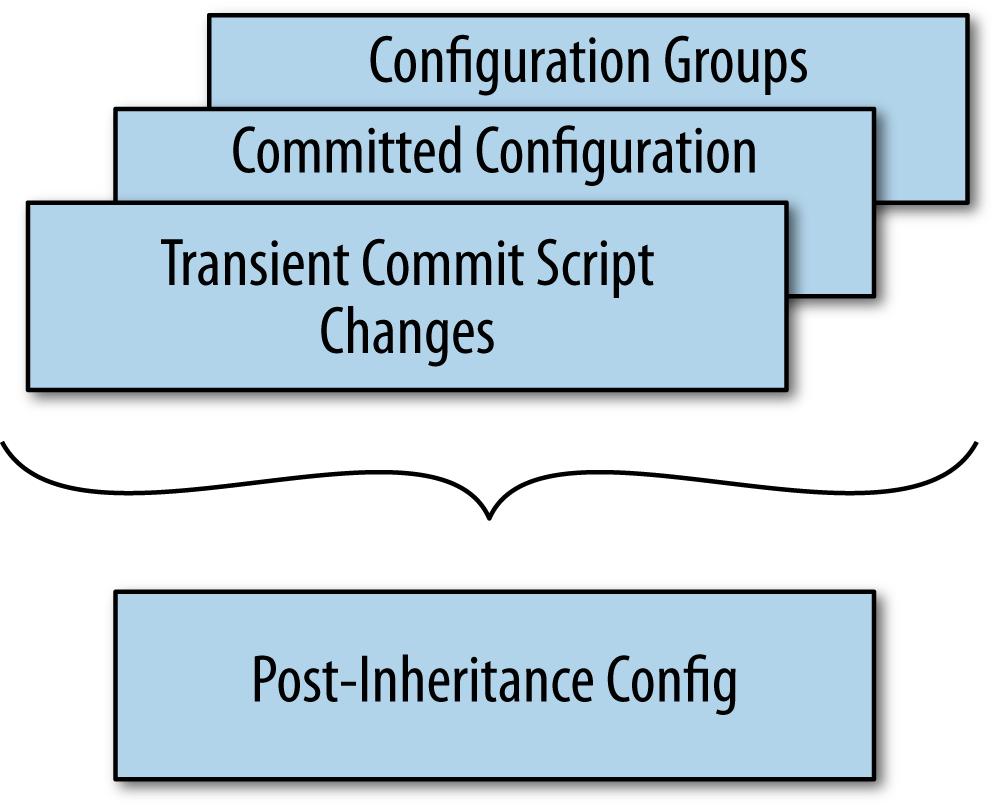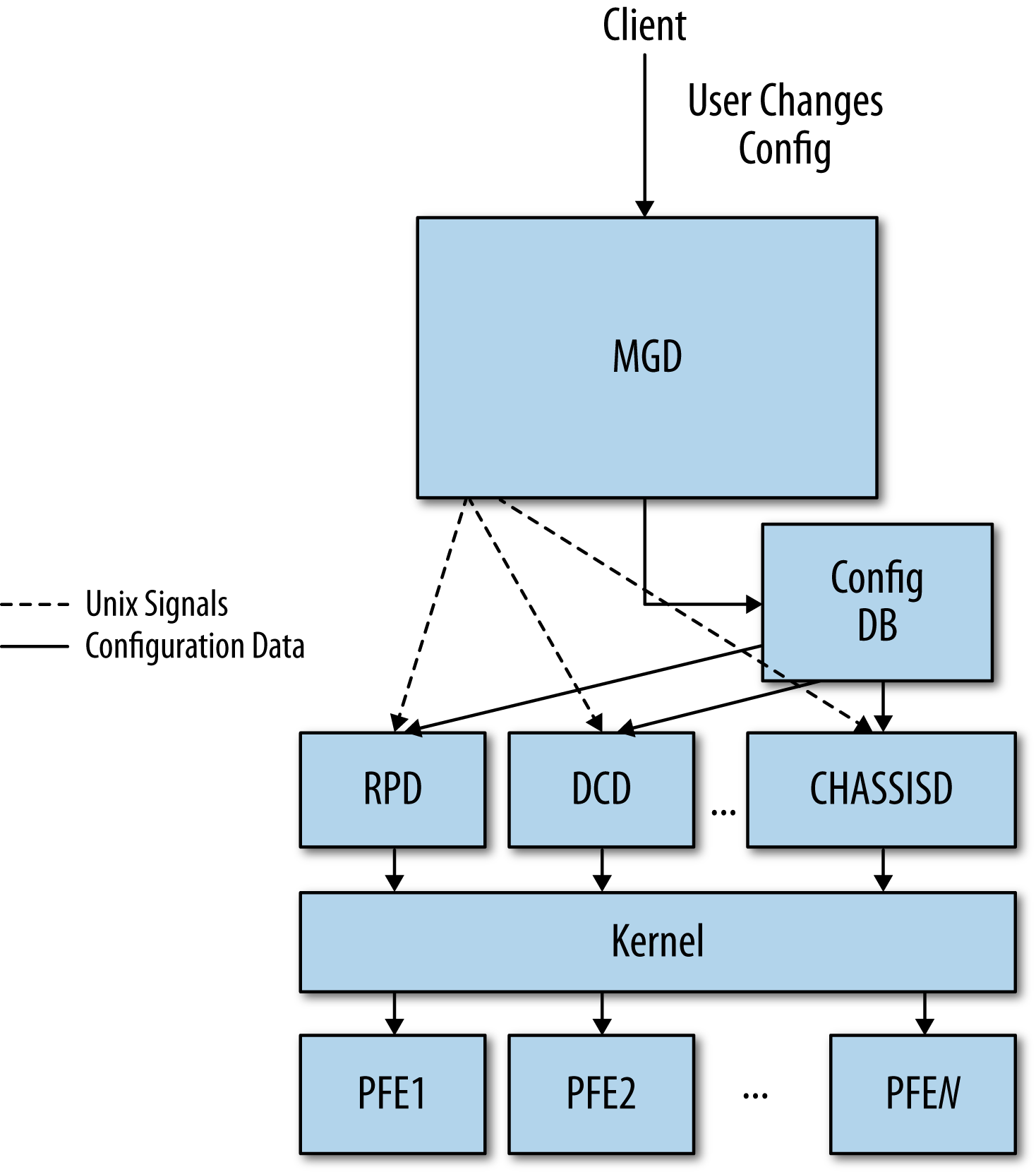Configuring the Junos system’s management daemon (MGD)
Learn how configuration data flows and how the commit process works.
 Three Gorges Dam from space (source: NASA via Wikimedia Commons)
Three Gorges Dam from space (source: NASA via Wikimedia Commons)
When managing Junos devices, it is helpful to understand the way configuration data is validated and activated. When you commit a configuration change, a lot of work happens behind the scenes to ensure that you end up with a working configuration that is applied to all the appropriate components of the system.
The commit process
When you execute the commit
command, the Junos software follows a carefully orchestrated process to
ensure that the device ends up with a usable configuration.
Note
In this process, we describe a system with redundant routing engines (REs). In fact, we describe a
system with more than two REs, as that system follows the most
complicated commit process. To simplify this process for a system with
fewer REs (even a single-RE system), simply omit the steps that apply
to the other REs.
The steps are as follows:
-
The master RE runs its commit checks. This may include:
-
Checking for consistency in the data. (For example, if a
BGP group refers to a policy, that policy should be
defined.) -
Running commit scripts. (Commit scripts can return
warnings or errors that are caught at this stage.) -
Running daemons in a special mode that conducts more
in-depth analysis of the candidate configuration.
-
-
The master RE pushes the configuration to the other REs and
asks those REs to conduct their commit checks. -
The other REs activate the new configuration.
-
The master RE activates the new configuration.
If an error is detected at any step in the process, the commit
process is aborted and the software returns to using the previous active
configuration.
This process enforces a contract with the user: Junos will take
the time it needs to thoroughly validate that the configuration is
acceptable, and in return it will ensure that the Junos software
components will be able to parse the configuration at the end of the
process. In essence, you are sacrificing time in return for
reliability.
Validating the configuration
The management daemon validates that each statement
is syntactically correct. (Here,
“syntactic correctness” refers to each command being properly formed
and constructing a valid configuration block.) If it notices a
problem, it typically rejects the configuration statement.
Additionally, MGD conducts some semantic
checks as you modify the configuration. (Here, “semantic
correctness” refers to the state where the entire configuration is
coherent and understandable.) If it notices a problem, it typically
adds a comment to the configuration to warn you of the problem. In
this example, the BGP configuration references an export policy, but
the policy it references is not in the configuration:
[edit]
user@r0# show protocols bgp export
export does_not_exist; ## 'does_not_exist' is not defined
Once you commit the configuration, MGD will again conduct its
semantic checks; however, these checks will either result in an error
or warning, as appropriate. For example, if you attempt to commit the
configuration with the BGP export policy still undefined, you will see
this output:
[edit]
user@r0# commit
error: Policy error: Policy does_not_exist referenced but not defined
[edit protocols bgp]
'export'
BGP: export list not applied
error: configuration check-out failed
If the MGD semantic checks pass, MGD applies any commit scripts
that are listed in the candidate configuration. The commit scripts can
return warnings or errors. Warnings are displayed to the user but do
not impact the commit process. Errors are displayed to the user and
abort the commit process. (There is more information about commit
scripts in not available.)
If the commit scripts return no errors, MGD calls the various
daemons interested in the changes and asks them to verify that the
configuration is semantically correct. These daemons can return
warnings or errors. Again, both are displayed to the user, but only
errors abort the commit process.
Tip
Use the command commit to view the results of these commit checks without
check
actually committing the configuration.
Activating the configuration
When the RE activates the new configuration, the configuration is
merged with other data (such as the platform defaults and transient
changes from commit scripts). The new configuration then atomically
becomes the new “active” configuration.
Tip
You can see the platform defaults for a particular platform by
running the following command:
show configuration groups junos-defaults
These configuration statements are applied like any other
configuration group. That means that they can be overridden by user
configuration. (Put differently, configuration groups are applied
“behind” the user-supplied configuration, which means that
user-supplied configuration can obscure conflicting portions of the
default configuration.) This is a fancy and long-winded way of
saying that the default configuration statements behave exactly the
way you would expect default configuration statements to
behave.
Signaling daemons
Once the configuration is committed, MGD makes any changes it needs to make (such
as adding or deleting user accounts, or other changes that MGD is
responsible for making) and signals other daemons to read the new
configuration and activate the configuration changes each is
responsible for. Because the Junos software tracks the changes a user
has made, it only needs to signal the daemons that are interested in
the parts of the configuration that have changed. Therefore, depending
on the exact change, MGD may signal more or fewer daemons to reread
the configuration. This means the device may do more or less work for
each configuration change, depending on the content of the
change.
Note
This behavior becomes more relevant as the size of the
configuration grows. For example, it takes much less time for the
routing protocol daemon (RPD) to read a configuration
with only a single routing instance and 10 static routes than it
does for RPD to read a configuration with 1,000 routing instances
and 400,000 static routes. Knowing the nature of your commit
performance can help you develop smart strategies for handling
configuration commits.
You can see this behavior by adding the | display detail directive to the end of the commit
command. This causes the CLI to display the details about the activities MGD
undertakes in order to activate the configuration. Among other
details, you should see which daemons MGD signals to reread the
configuration.
In rare circumstances you may encounter a bug in the logic that
may cause MGD to miss signaling a daemon. (Juniper doesn’t like to see
those bugs, but they can occur occasionally.) In those cases, you can
use the command commit full
to cause MGD to take all the actions to commit the entire
configuration without regard to what has changed. If you do this, MGD
acts as if the entire configuration has changed and all daemons are
signaled to reread their configuration.
Creating the merged configuration view
Figure 1-1 gives
a fuller expansion of the way configuration data,
including transient commit script changes and platform defaults, is
combined into a “merged view” that the daemons can use to activate the
new configuration.

sources
In general, configuration data is applied with this
precedence:
-
Transient changes from commit scripts
-
The committed configuration (note that this includes any
permanent changes made by a commit script) -
Configuration applied from configuration groups (which
includes platform defaults)
Note
not available contains more information
on commit scripts, including the difference between transient and
permanent configuration changes. For now, it is sufficient to
understand that commit scripts can produce different kinds of
changes, which will be applied with different precedence.
Actually, to be a little more precise, transient changes from commit scripts, the
committed configuration, and configuration groups in the static
configuration are merged together. After the data from these various
sources is merged together, this “merged” view of the configuration
(you can call it the “post-inheritance” configuration) is what the
various daemons read when they activate a new configuration.
Note
Configuration groups are only applied to configuration in the
static configuration database. They are not applied to transient
changes from commit scripts.
Configuration data flow
When you commit configuration changes, the new configuration data
is placed into a shared database that all the daemons can access. When
this configuration database changes, MGD uses Unix signals to signal the
appropriate daemons to reread the new configuration. After reading the
configuration, the daemons activate its contents. If the new
configuration requires changes in the forwarding plane, this data will
be propagated to the PFEs. This process is illustrated in Figure 1-2.

